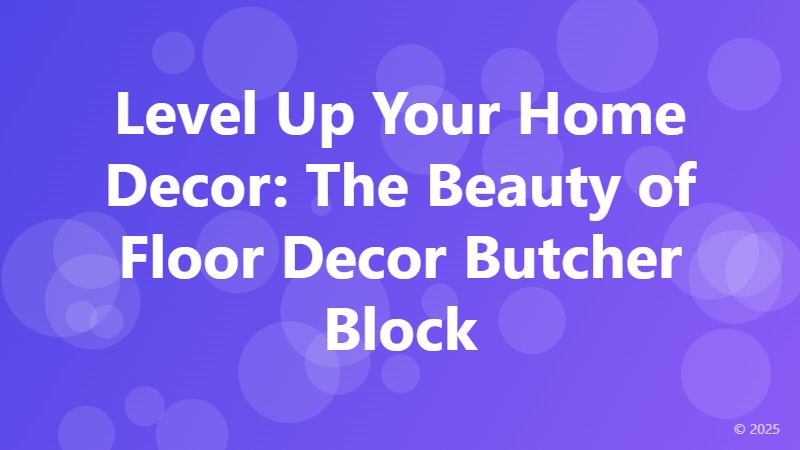Level Up Your Home Decor: The Beauty of Floor Decor Butcher Block

Floor decor butcher block is a type of flooring that has gained immense popularity in recent years, and for good reason. Not only does it add a touch of rustic charm to any room, but it's also incredibly durable and easy to maintain. In this article, we'll dive into the world of floor decor butcher block, exploring its benefits, installation process, and design ideas to inspire your next home renovation project.
What is Floor Decor Butcher Block?
Floor decor butcher block is a type of engineered hardwood flooring made from layers of wood pressed together to form a solid plank. The top layer is typically made from high-quality hardwood, such as maple or walnut, which is where the butcher block gets its signature look. The layers beneath are usually made from softer woods, such as pine or fir, which provide stability and support.
Benefits of Floor Decor Butcher Block
So, what makes floor decor butcher block so special? For starters, it's incredibly durable and resistant to scratches and dents. Unlike traditional hardwood flooring, butcher block is less prone to warping and shrinking, making it an ideal choice for high-traffic areas. Additionally, it's easy to clean and maintain, and can be refinished multiple times to extend its lifespan.
Another major benefit of floor decor butcher block is its unique aesthetic appeal. The layered construction creates a beautiful, rustic pattern that adds warmth and character to any room. Plus, the natural wood grain and color variations give each plank a one-of-a-kind look that's sure to impress.
Installation Process
Installing floor decor butcher block is a relatively straightforward process, but it does require some planning and preparation. Here are the basic steps to follow:
1. Prepare the subfloor: Ensure the subfloor is level, clean, and dry before installation.
2. Lay the underlayment: Install a layer of underlayment material, such as plywood or cement-based underlayment, to provide a smooth surface for the butcher block planks.
3. Lay the planks: Begin installing the butcher block planks, starting from the center of the room and working your way outward. Use a tapping block and a hammer to secure the planks in place.
4. Sand and finish: Once the planks are installed, sand the entire floor to smooth out any imperfections. Apply a finish, such as a polyurethane coating, to protect the wood and enhance its appearance.
Design Ideas
Floor decor butcher block is an incredibly versatile material that can be used in a variety of design styles, from modern to traditional. Here are a few design ideas to get you started:
1. Rustic Charm: Pair floor decor butcher block with natural stone walls and reclaimed wood accents for a cozy, rustic look.
2. Modern Farmhouse: Combine butcher block flooring with sleek, modern furniture and statement lighting for a chic, farmhouse-inspired aesthetic.
3. Coastal Cool: Use floor decor butcher block in a coastal-inspired design, pairing it with light-colored walls, natural textiles, and nautical accents.
In conclusion, floor decor butcher block is a unique and versatile flooring option that offers a range of benefits and design possibilities. With its durability, ease of maintenance, and rustic charm, it's no wonder why it's become a popular choice among homeowners and designers alike. Whether you're looking to renovate a single room or an entire house, floor decor butcher block is definitely worth considering.